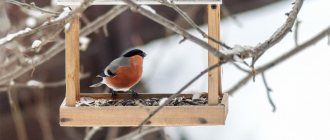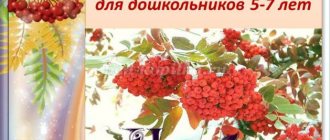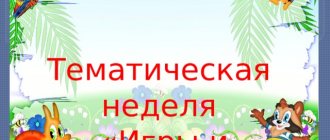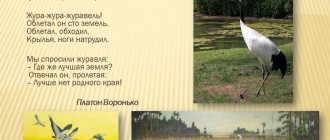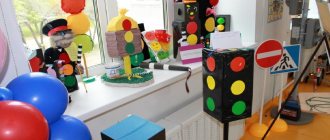Calendar and thematic planning for the week, on the topic: “Wintering birds”
MorningReception of children in a group. Morning rhythmic gymnastics in the music room.
Looking at the album “Birds” in a corner of nature.
Offer children stencils of birds for free activity in the art activity corner.
Individual work:
1.Speech development. Learning to tell a story from a picture. Goal: to train children to look at a picture and talk about it in a certain sequence; learn to come up with a title for a painting.
2.Cognitive development. (FEMP) D/i “Close the windows in the houses.” Goal: to exercise the ability to select geometric shapes.
3.Physical development. Game exercise “Don’t knock down the flag.” Target:
practice walking like a snake between objects without knocking them over.
4. Social and communicative development. Situation “Home Alone” Purpose: to exercise the ability to manage oneself in difficult, frightening situations.
Walk 1
Sparrow watching
Target:
deepen knowledge about the features of a sparrow’s appearance and life manifestations;
activate children's attention and memory.
Progress of observation
What does a sparrow look like? What does he eat?
How does he move? How does he sing?
The sparrow is a small, lively bird. The sparrow's back is brown, with wide longitudinal black stripes. The tail and wings are dark brown, decorated with a reddish border, the chin and throat are black, but the head is gray. The sparrow is an agile bird, unafraid to jump near a person’s feet, peck from a dog’s bowl, and pick up crumbs, seeds, and grains. It adapts well to human habits everywhere. The sparrows sing "chick-chirp".
Labor activity
Weeding beds in the garden of a kindergarten - strengthen children's ability to distinguish weeds by appearance.
Outdoor games
“Baba Yaga” - teach to follow the rules of the game: walk, run easily and rhythmically, changing the direction and pace of movement.
“Find yourself a partner” - teach to move quickly according to a signal, changing the direction of movement.
“Catch the ball” - continue to strengthen the skills of throwing and catching the ball with both hands; cultivate attention and dexterity.
Individual work
“On a level path” - teach children to walk in a column, one at a time, along a narrow path.
Optional games with external material.
Evening.
Health-improving gymnastics after sleep. Air hardening. Corrective exercise (walking on massage mats with buttons).
Reading V. Berestov “What are the sparrows singing about?” Goal: To create a joyful mood in children while listening to the poem, to help them remember the verse.
Individual work:
1.Cognitive development.
Didactic game
"What is made of what"
Goal: develop the ability to determine what material objects are made of
2. Social and communicative development. Conversation “A good friend is a friend in need”
Goal: to form the idea that a true friend knows how to empathize and help in difficult times; develop the ability to be merciful to each other.
3. Speech development. D/i “What kind of bird” Purpose: to teach children to describe birds by their characteristic features and recognize them by description, imitate the movements of different birds, develop speech and thinking.
Walk 2.
Snow and Ice Observation
Target:
develop a realistic understanding of inanimate nature; consolidate knowledge that water can be in a solid state (snow, ice).
Progress of observation
Oh, you winter beauty! Whitewashed all the forests
She swept up mountains of snow and invited us to go for a ride.
The teacher conducts an experiment and asks the children questions. Place ice in one glass and snow in the other. What color does ice (snow) feel like? Name their properties. What are snow and ice made of? Now we put both glasses in a warm place, after a while we’ll see what happens to the ice and snow.
Ice-strongman experience
- pour water into a bottle and put it in a snowdrift at the end of the walk, examine the bottle, it is cracked - the volume of ice is always greater than the volume of water from which it was made; learn to draw conclusions.
Labor activity
: Clearing the area of snow
Target:
reinforce ideas about the protective properties of snow.
Outdoor games:
“Entertainers”, “Firemen in training”
Target:
strengthen the ability to run, dodge a trap, crawl under an obstacle. "Find yourself a mate"
Target:
develop agility, balance, endurance, spatial orientation
Individual
work:
Movement development
Target:
learn to throw snowballs into the distance.
Games at the request of children
Calendar plan of educational work for the week “Wintering Birds” in the senior group
Written Elena
Calendar plan of educational work for the week “Wintering Birds” in the senior group
Work plan from January 20 to 24
Topic: “ Wintering birds ”
Tasks:
— Form ideas about wintering birds (their living conditions, the role of humans in the life of wintering birds );
— Strengthen the ability to recognize a bird by its habits , appearance, songs;
— Foster a caring attitude and a desire to help in difficult winter conditions.
Day of the week , date Educational areas Joint activities of adults and children, taking into account the integration of educational areas Organization of a developmental environment for independent activity Interaction with parents
Direct educational activities Educational activities in special moments
Group , subgroup individual
1 2 3 4 5 6 7
Cognitive development Knowledge of the surrounding world
Topic: “History of paper”
Program objectives: Introduce children to the history of paper creation; consolidate knowledge about different types of paper, their properties and qualities; activate children's vocabulary, develop attention and thinking.
Equipment: various types of paper (cardboard, tracing paper, corrugated paper, notebook sheet, napkin)
Dictionary: birch bark, parchment With Vika S., Arina S. D/I “Complete the object”
goal: to consolidate the ability to determine the shape of surrounding objects. Morning
-Morning exercises
— Finger gymnastics “Birds”
goal: to develop speech and fine motor skills.
— Examination of illustrations of wintering birds goal : to consolidate ideas about wintering birds .
-D/I “What’s ringing?”
goal: to develop phonemic hearing, to consolidate musical instruments.
-D/I “What sign is hidden?”
goal: to clarify knowledge about road signs, to develop attention.
— H/R “Kite”
goal: create a joyful mood, perform movements in accordance with the text.
Illustrations of wintering birds , musical instruments (tambourine, drum, rattle, metallophone, pipe, pictures of road signs, paper, felt-tip pens. Bring bird
Monday , January 20 Artistic and aesthetic development
Physical development Drawing
Topic: “Bullfinches on a branch”
the image of birds - bullfinches - in drawings ; form, convey characteristic details, the relationship of objects and their parts in size, height, location relative to each other; improve visual skills and abilities , develop artistic and creative abilities; cultivate a caring attitude towards birds and goodwill.
Equipment: illustrations of bullfinches, paper, watercolors, brushes, glasses of water, oilcloths, napkins, a simple pencil.
Vocabulary: red-breasted, flock.
Physical education Walk
-Bird watching
— Work “Let’s feed the birds ”
— P/N “One, two, three – run”
Work before bed
Reading the work of E. Charushin “Sparrow”
goal: to consolidate the ability to listen and answer the teacher’s questions.
bird food .
Work by E. Charushin “Sparrow”
With Arina D., Maxim G. D/I “Which number is missing?”
goal: develop visual attention, consolidate numbers up to seven. Evening
-Gymnastics after sleep, hardening activities
-Work “Let’s wash the flowers”
goal: to cultivate hard work
— D/I “What birds you won’t see in winter ”
goal: to clarify knowledge about the characteristics of
wintering birds .
-S/R “Let’s treat the birds ”
goal: to consolidate the ability to unite the game with a common plot, to coordinate the actions of oneself and one’s comrades, to consolidate the profession of veterinarian.
-P/I “Owl - owl”
Goal: practice running.
Illustrations of wintering birds , a set of numbers, attributes for S/R, a basin of water, cotton wool, aprons, indoor flowers, an owl mask, plasticine, boards, stacks, hoops, sandbags. Consultation “Beware of the flu”
Cognitive development Mathematics
Program tasks: Show children the quantitative composition of the number 7 (from individual units)
; exercise children in counting to seven; consolidate knowledge of numbers from 1 to 7; practice dividing a square, circle, triangle into two equal parts; develop in children voluntary attention, the ability to negotiate with their eyes, and find a partner in the game; practice distinguishing the shapes of surrounding objects.
Equipment: math sets, a set of magnetic numbers, small toys, paper blanks, scissors. With Sonya K., Dasha M. D/I “Highlight the sound”
goal: to consolidate the ability to isolate sounds in words. Morning
-Morning exercises
— Finger gymnastics “Bullfinch”
goal: to develop speech and fine motor skills.
-Conversation “ Birds in winter ”
goal: to consolidate ideas about
wintering birds (their living conditions, the role of humans in the life of wintering birds ).
-D/I “Curious Magpie”
goal: to improve children’s ability to use prepositions in speech.
— D/I “Guess the melody”
goal: to develop musical abilities.
— H/R “Bells – bells”
: create a joyful mood, perform movements in accordance with the text.
Illustrations of wintering birds , birds in winter bird melodies , ball, coloring pages, wax pencils, arcs, gymnastic sticks. bird feeders .
Tuesday January 21 Artistic and aesthetic development
Music
Modeling
Topic: “Magpie – white-sided”
Program objectives: To develop children’s ability to convey the image of a magpie using combined (constructive and sculptural)
by sculpting, to convey the features of the external appearance
(the structure of the body, the shape of the head, wings, tail, characteristic coloring)
; consolidate the techniques of rolling, flattening, coating, dividing into parts using stacks; develop composition skills.
Equipment: illustrations of wintering birds , plasticine, boards, stacks, napkins. Walk
-Wind observation
— Work “Let’s clear the path”
-P/I “Traps”
Work before bed
Reading the work of V. Sukhomlinsky “Red-breasted Bullfinches”
goal: to consolidate the ability to listen carefully and answer questions.
bird food .
The work of V. Sukhomlinsky “Red-breasted Bullfinches”
.
With Vika S., Darina Sh., D/I “Right, Left”
goal: to consolidate the ability to navigate in space. Evening
— Gymnastics after sleep, hardening activities.
— Observation of the houseplant “Zygocactus”
goal: to consolidate knowledge about indoor plants (structure, care, cultivate a love of nature.
— Theatrical activities on the river. n. With. “Winged, furry and oily”
goal: to create a joyful mood, remember a fairy tale, play simple roles.
— D/I “Finish the sentence”
goal: to consolidate knowledge about objects of the man-made world and the types of materials from which they are made.
- D/I “I know...”
goal: to consolidate the ability to classify objects and phenomena according to one criterion.
-P/I “Hunter and Ducks”
Goal: practice running.
Illustrations of wintering birds , houseplant, magnifying glass, theater paraphernalia, ball, soft toys, plasticine, boards, stacks, jump ropes, ring throw.
Talk to Lyosha S.’s mother. Fix the numbers to 7. Speech development Speech development
Topic: “Visiting wintering birds ”
Program objectives: Expand children's vocabulary with nouns, adjectives, verbs; fix prepositions in speech (in, on, under, before, behind, above, etc.)
;
develop coherent speech, expand the scope of visual and auditory attention, memory; improve the grammatical structure of speech (
formation of complex adjectives) ;
form verbs using prefixes at, about, for, you, at, per;
develop logical thinking. Equipment: illustrations of wintering birds , feeders, trees.
Vocabulary: motley-winged, red-headed. With Arina U., Maxim G. D/I “One is many”
goal: to consolidate the concept of one, many. Morning
-Morning exercises
-Conversation “Vitamins are our friends”
goal: to consolidate the names of vitamins, their benefits and importance for health.
— D/I “Guess”
goal: to consolidate the ability to solve riddles and develop speech.
— Singing the song “Little Secret”
goal: to develop musical abilities.
-D/I “Find the missing number”
goal: to consolidate understanding of the relationships between adjacent numbers
(within 7)
X/R “Winter Carousel”
goal: to create a joyful mood, perform movements in accordance with the text Illustrations of
wintering birds , vegetables, fruits, a set of magnetic numbers, coloring books, colored pencils, a town, balls, hoops, Lego
Consultation
“Let's feed
the birds in winter ” Wednesday, January 22 Artistic and aesthetic development
Physical development Construction
Topic: “ Wonderful bird ”
Program tasks: To develop skills in folding a sheet of paper like an accordion, ironing the folds; improve the technique of cutting according to a template; improve the technique of gluing identical parts; develop imagination ; cultivate accuracy, hard work, and the ability to listen.
Equipment: pictures of birds , colored, white paper, templates, scissors, pencil, boards, glue, napkins
Outdoor exercise Walk
-Tree watching
-Work “Let’s Wrap the Trees”
- F/N “Don’t hurt me!”
Work before bed
Reading the work of Y. Yashin “Feed the birds in winter ”
goal: to consolidate the ability to listen carefully and answer questions.
Ice cubes, shovels, bird
Work by Y. Yashin “Feed the birds in winter ”
With Varya A., Roma M. D/I “Build a staircase”
goal: to consolidate the ability to build a serial row of five objects along the length in both directions. Evening
— Gymnastics after sleep, hardening activities
-Work “Let's treat books”
goal: to cultivate hard work and love of books.
-D/I “They fly away - they don’t fly away”
goal: to consolidate knowledge about
wintering and migratory birds , to develop visual and auditory attention.
— Multimedia “For children about wintering birds ”
goal: to create a joyful mood, consolidate knowledge about
wintering birds , recognize them by their habits and appearance.
-D/I “What does the traffic light say?”
goal: to consolidate the rules of behavior on the city street, the role of the traffic light signal.
-P/I “Birds in nests”
goal: to practice running, the ability to respond to a signal.
Illustrations of wintering birds , traffic lights, laptop, books, scissors, paper, glue, colored strips of paper of different lengths, hoops, coloring books, colored pencils.
Bring garlic and onions. Artistic and aesthetic development
Application
Topic: “Bullfinches on a branch”
Program tasks: To develop the ability to convey in an application the image of a bullfinch , the features of the shape of the head and body, tail (cutting out in parts from colored paper, observing the relative size, to convey the color of the bullfinch; to develop the ability to beautifully arrange images on a sheet ; to consolidate the ability to take part in team work , find a place for your image in the overall composition ; develop aesthetic perception.
Equipment: Whatman paper, blanks of colored paper, scissors, glue, boards, napkins, illustrations of bullfinches. With Zhenya Ts., Darina Sh. D/I “Don’t be mistaken”
goal: navigate in space, develop quantitative concepts. Morning
— Morning exercises
— Finger gymnastics “Woodpecker”
goal: to develop speech and fine motor skills.
-Conversation “When adults talk”
goal: to consolidate the skills of politely
addressing adults , not interrupting them, not interfering in the conversation of adults.
— Consideration of the children's encyclopedia “ Birds ”
goal: to expand ideas about
wintering birds , the role of humans in the life of wintering birds .
— Singing the song “Antoshka”
goal: to develop musical abilities.
-D/I “Say in one word”
goal: to practice
the formation of complex adjectives.
-H/R “The Blizzard Has Blizzled”
goal: create a joyful mood, perform movements in accordance with the text.
Illustrations of wintering birds , the Birds
encyclopedia a town, hoops, sandbags.
Conversation “What books do your children like”
Thursday, January 23 Artistic and aesthetic development
Speech development Music
Perception of fiction
Topic: M. Gorky “Sparrow”
Program objectives: Expand children's understanding of the genre features of a fairy tale; develop moral qualities: honesty, admitting one's mistakes; conduct a basic analysis of a fairy tale: beginning, content and end; cultivate a love of literature.
Equipment: M. Gorky’s work “Sparrow”
Walk
-Observation of snowdrifts
-Work “Let’s rake the path”
-P/N “Don’t hurt me”
Work before bed
Reading the work of I. Tokmakova “Pigeons”
goal: to consolidate the ability to listen carefully and answer the teacher’s questions.
bird
food Work by I. Tokmakova “Pigeons”
With Arina U., Darina Sh.
D/I “Collect a fairy tale”
goal: to consolidate the ability to compose 12 parts. Evening
— Gymnastics after sleep, hardening activities
— D/I “Water is not water”
goal: to consolidate knowledge about inanimate nature - water
(in various states)
.
—D/I “Settled into houses”
goal: to consolidate the ability to decode and identify blocks based on three characteristics.
— Watching the educational cartoon “Where the Birds Winter ”
goal: to create a joyful mood, consolidate knowledge about
wintering birds .
— D/I “Count the birds ”
goal: to coordinate numerals with nouns.
-P/I “Sparrows and the car”
goal: to exercise loose running.
Illustrations of wintering birds , water in different states, Dienesh blocks, laptop, hoops, colored paper, scissors. Consultation “How to make a feeder at home”
Cognitive development Nature
Topic: Bird life ”
Program objectives: To form children's ideas about the life of wintering birds , to form a desire to help them; show the interdependence of living and inanimate nature; cultivate a good attitude towards nature.
Equipment: illustrations of wintering birds bird food , ball. With Roma M, Andrey R. D/I “Arms - Legs”
goal: to develop attention and coordination of movements while counting.
Morning
-Morning exercises
— Finger gymnastics “Crow”
goal: to develop speech and fine motor skills.
-Conversation “What can you feed the birds ”
goal: to consolidate knowledge about
birds bird
food - singing “Smile”
goal: to develop musical abilities.
-D/I “What a sign”
goal: to consolidate knowledge about road signs.
-D/I “ Form ”
goal: expand and activate vocabulary.
Practice forming active present participles.
-H/R “Burn, burn – clear”
goal: create a joyful mood, perform movements in accordance with the text.
Illustrations of wintering birds , feeders, road signs, scarf, plasticine, boards, stacks, balls, baskets. Conversation “How do you spend your weekend”
Friday, January 24 Physical development
Speech development Physical education
Speech development
Topic: “We are storytellers”
Program objectives: To develop children’s ability to reproduce short stories close to the text; develop auditory perception, intonation expressiveness; clearly and correctly identify the sound z in words and phrases, select words with a given sound; compose sentences with words that contain a given sound z; find the place of the sound in a word: the beginning, middle or end of the word.
Equipment: pictures with sound, ball. Walk
— Watching snowfall
-Work “Collecting snow into a pile for construction”
— P/N “Hit the target”
Work before bed
Reading the work of L. Voronkova “Bird Feeders”
goal: to consolidate the ability to listen carefully and answer the teacher’s questions.
bird
food Work by L. Voronkova “Bird feeders”
With Lesha S, Darina Sh. D/I “Our Day”
goal: to consolidate ideas about the parts of the day Evening
— Gymnastics after sleep, hardening activities
-Work “Let’s water the flowers”
goal: to cultivate hard work
— Memorizing the poem by N. N. Sozonova “Winter is cold”
goal: to develop memory, the ability to remember, to consolidate knowledge about
wintering birds .
- D/I “What, where?”
goal: to consolidate the ability to navigate in space.
-Final product Physical education “Friendly guys”
goal: to create a joyful mood, instill a love of sports, to train children in running, jumping, throwing.
wintering birds coloring pages : to consolidate the ability to color without going beyond the outline, to consolidate wintering birds . Illustrations of wintering birds , parts of the day, a watering can with water, soft toys, balls, hoops, gymnastic sticks, coloring books, colored pencils. Conversation “how to harden children”
Topic of the week: Wintering birds
A set of exercises for sounds [SH], [F]
"Smile"
- smile widely, hold the smile for 5 - 7 seconds.
"Fence"
- smile broadly, show clenched teeth (the upper teeth sit exactly on the lower ones). Hold this position for 5-7 seconds.
"Pipe (elephant)"
- stretch your lips forward like a tube (teeth clenched). Hold for 5-7 s.
Alternate “fence” and “elephant”.
The lower part does not move, only the lips move. Repeat 5-6 times
"Delicious jam"
- use the wide flat tip of your tongue to lick your upper lip from top to bottom (the tongue licks the “jam” in one motion into the mouth). In this case, the lower teeth should be visible (the lower lip is pulled down, the teeth do not bite the tongue). Repeat 3-5 times.
"Swing"
- lips in a smile, mouth slightly open, place the tip of the tongue behind the upper teeth (the tongue rests on them), then lower it behind the lower teeth (the tongue rests on them).
“Blow on
your nose”
- stick out the wide tip of your tongue, lift it to your upper lip (as in the “Delicious Jam” exercise) and blow upward (“Imagine that a fly lands on your nose - you need to blow it away!”). The air flows through the middle of the tongue, the cheeks do not inflate. Repeat 4-5 times.
"Cup"
- open your mouth wide, smile. Stick your tongue out of your mouth, lifting its front and side edges, forming a “cup” (as in the exercises “Delicious jam”, “Blow on your nose” - only the mouth is open wider, teeth are visible)). Hold this way for 5-10 s. Repeat 2-4 times.
"Brushing our teeth"
- open your mouth wide, smile, showing your teeth. Then use the tip of your tongue to “brush your teeth” from the inside, moving it left and right (first the lower ones, then the upper ones). The tip of the tongue should be behind the teeth. The lips smile all the time, the lower jaw does not move. Repeat 5-6 times.
Set of exercises for sound [L]
"Smile"
- smile widely, hold the smile for 5 - 7 seconds.
"Kneading the dough"
- spank the wide flat tip of the tongue with your lips, saying “five-five-five”, then “ta-ta-ta.” Repeat 3 - 5 times.
"Brushing our teeth"
- open your mouth wide, smile, showing your teeth. Then use the tip of your tongue to “brush your teeth” from the inside, moving it left and right (first the lower ones, then the upper ones). The tip of the tongue should be behind the teeth. The lips smile all the time, the lower jaw does not move. Repeat 5-6 times.
"Watch"
- open your mouth slightly, stick out your tongue and move it left and right, from one corner of your mouth to the other. Repeat movements 5-6 times in each direction.
"Nuts"
- rest the tip of your tongue on your cheek (lips are closed and teeth are apart) - “there is a nut behind the cheek”, press lightly with your finger on the cheek and tongue (the tongue resists pressure) - “the nut is hard” Repeat 2-4 times with each cheek.
"Catch the Mouse"
- lips in a smile, mouth slightly open, say “a-a-a-a” and bite the tip of your tongue - you get “a-a-al” (caught the mouse by the tail!).
"Painter"
- the mouth is slightly open, we move the tip of the tongue forward and backward along the palate (“paint with a brush”).
A set of exercises for sound [P]
"Swing"
- lips in a smile, mouth slightly open, place the tip of the tongue behind the upper teeth (the tongue rests on them), then lower it behind the lower teeth (the tongue rests on them).
"Brushing our teeth"
- open your mouth wide, smile, showing your teeth. Then use the tip of your tongue to “brush your teeth” from the inside, moving it left and right (first the lower ones, then the upper ones). The tip of the tongue should be behind the teeth. The lips smile all the time, the lower jaw does not move. Repeat 5-6 times.
"Painter"
- the mouth is slightly open, we move the tip of the tongue forward and backward along the palate (“paint with a brush”). Repeat 5-6 times.
"Horse"
- open your mouth slightly, smile, showing your teeth. Click your tongue with short pauses to rest. Try not to move your lower jaw.
"Fungus"
- the mouth is slightly open, the lips are in a smile, we slowly click the tongue (like the “Horse” exercise, only slower), suck the tongue to the palate (the tongue is spread out across the palate - this is the “mushroom cap”, the frenulum of the tongue is taut - this is the “leg”). Hold for 3 - 4 seconds. Repeat 5-6 times.
"Woodpecker"
— the mouth is slightly open, the lips are in a smile. We quickly say “d-d-d-d.” At the same time, the tip of the tongue knocks behind the upper teeth, the lower jaw is motionless!!!.
"Komarik
“- the mouth is slightly open, the lips are in a smile. The tip of the tongue rests on the tubercles behind the upper teeth. We pronounce something between “Z-z-z” and “Z-z-z”. We pronounce it with force (so that it tickles the tongue).
"Harmonic"
— we do the “Mushroom” — we suck on the tongue, raise and lower the lower jaw (stretch the frenulum).
